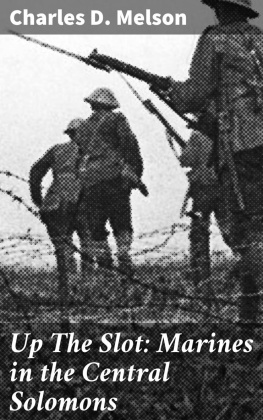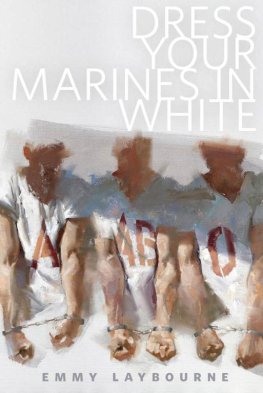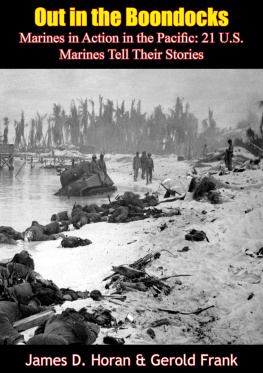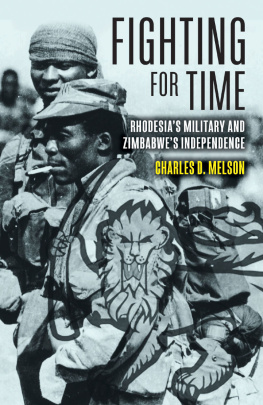Up the Slot:
Marines in the Central Solomons
Table of Contents
by Major Charles D. Melson, U.S. Marine Corps (Ret)
Operation Watchtower was the codename assigned by the Joint Chiefs of Staff for the reduction of the Japanese stronghold at Rabaul, on the easternmost tip of New Britain Island in the Bismarck Archipelago. The plan called for the South Pacific Area forces of Vice Admiral Robert L. Ghormley (relieved in November 1942 by Vice Admiral William F. Halsey) to move up the chain of the Solomon Islands toward Rabaul, beginning with the Guadalcanal landings on 7 August 1942. In December that year, patrol flights taking off from Henderson Field on Guadalcanal and from the decks of U.S. fleet carriers in the waters around the Solomon Islands discovered the Japanese hard at work on a well-camouflaged airfield at Munda on the northern end of New Georgia. This new field posed a definite threat to the Allies still fighting to wrest Guadalcanal from the enemy. It had to be taken, or at the very least, neutralized. U.S. pilots also reported another field being completed on Kolombangara across the Kula Gulf from New Georgia.
In response to these potential threats, Operation Toenails, landings in the New Georgia Islands in the Central Solomons with the capture of Munda as the primary objective, were planned, scheduled, and mounted. The first step leading to the invasion of New Georgia was the occupation of the Russell Islands, 65 miles northwest of Guadalcanal, which would serve as a forward base on which airfields would be constructed. Operation Cleanslate on 21 February 1943 saw the Marine 3d Raider Battalion (Lieutenant Colonel Harry B. Liversedge) land on Pavuvu, and the 43d Infantry Division (less a regimental combat team) invade Banika. Both landings were unopposed. The 11th Defense Battalion landed on Banika the same day and had its guns in place by noon. By 15 April, Allied aircraft began operating from the first of two new airstrips the Seabees constructed on Banika.
The primary objective of Operation Toenails was the capture of the airfield on Munda in the New Georgia group. Preliminary landings to support the main effort were to be made at Wickham Anchorage on Vangunu Island, Viru Harbor, and the Bairoko Harbor areas of New Georgia. Rendova Island and smaller islands nearby, across Blanche Channel to the south of New Georgia, were to be occupied next and used as supply bases and also as artillery positions for delivering supporting fire for the main attack on Munda. The plan called for ground forces then to drive the Japanese into the Munda Point area and once they were there, Allied air, artillery, and tanks could support the main landing. The enemy would be annihilated or forced into a costly withdrawal, according to the Allied concept of the operation.
For Toenails, Rear Admiral Richmond Kelly Turner, Amphibious Force Commander, divided his assigned forces into two task groups: Western Force, which he would personally command, was to seize Rendova, Munda, and Bairoko. The Eastern Force, under Rear Admiral George H. Fort, also an experienced amphibious force commander, was directed to capture Wickham Anchorage, Segi Point, and Viru Harbor. Turners ground commander was Army Major General John H. Hester, who headed the New Georgia Occupation Force (43d Infantry Division; Marine 9th Defense Battalion; the 136th Field Artillery Battalion from the 37th Infantry Division; the 24th Naval Construction Battalion (Seabees); Company O of the 4th Marine Raider Battalion; the 1st Commando, Fiji Guerrillas; and assigned service troops). Forts Eastern Force included Army Colonel Daniel H. Hundleys Army 103d Regimental Combat Team (RCT), less a battalion with Hester; Companies N, P, and Q of the 4th Raider Battalion; elements of the 70th Coast Artillery (Antiaircraft) Battalion; parts of the 20th Seabees; and service units. Colonel Harry B. Liversedges 1st Marine Raider Regiment (less the 2d, 3d, and 4th Battalions) was designated ready reserve for the operation, while the Armys 37th Infantry Division (less the 129th RCT and most of the 148th RCT) was held in general reserve on Guadalcanal ready to move on five days notice.

THE SOLOMON ISLANDS
1943
Hesters corps headquarters was formed by taking half of the 43d Division staff, the rest remaining with the Assistant Division Commander, Brigadier General Leonard F. Wing, USA. Over 30,000 men were in the units assigned to the New Georgia Occupation Force, the majority of which were Army troops, Marine and Seabee units, patrol-torpedo (PT) boat squadrons, and naval base personnel. Marines from the 10th and 11th Defense battalions were in reserve as reinforcements.
Col Harry B. Liversedge commanded the 1st Marine Raider Regiment and the XIV Corps Northern Landing Group. His mixed Army and Marine command was used as infantry rather than in the special operations role for which the raiders had been trained and equipped. Isolated from the main attack on Munda, he had to commit his forces to supporting operations.
Marine Corps Historical Collection

Defending the New Georgia Island Group were the Southeast Detachment of Major General Noboru Sasaki and the 8th Combined Special Naval Landing Force under Rear Admiral Minoru Ota (later to die as commander of Japanese naval forces at Okinawa); subordinate units included the 13th Infantry Regiment, 229th Infantry Regiment, Kure 6th Special Naval Landing Force, and the Yokosuka 7th Special Naval Landing Force. New Georgia and Kolombangara, and enemy outposts on Rendova, Santa Isabel, Choiseul, and Vella Lavella, were strongly defended. The number of Japanese occupying the outlying islands was comparatively small. The forces on Kolombangara were estimated at 10,000 troops while those on New Georgia were figured to be between 4,000 and 5,000.















